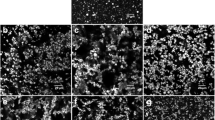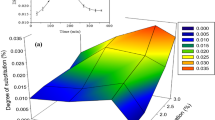Abstract
The O/W emulsions were prepared using perilla seed oil (PSO) dispersed in soy sauce (PSE) and in distilled water (PWE), respectively. Octenyl succinic anhydride-modified starch (OSA starch, 3 wt%) showed the most efficient emulsifying ability and its stabilities of emulsion and oxidation in PSE and PWE were studied at different storage periods (0, 4, and 8 weeks) and temperatures (4, 25, and 40 °C). Negligible change in droplet diameter of PSE was observed without coalescence or flocculation during storing for 8 weeks at 4 °C. The stabilizing ability of OSA-starch despite the high ionic strength of soy sauce is attributed to the starch backbone, which promotes steric repulsions between droplets. A lower oxidation degree was observed for PSE prepared than PWE and PSO under all storage conditions. Thus, the O/W emulsion prepared from PSO and soy sauce can be applied to the production of ω-3 fatty acid-enriched Asian-style emulsified products.






Similar content being viewed by others
References
Almoselhy RIM, Allam MH, El-Kalyoubi MH, El-Sharkawy AA. 1H NMR spectral analysis as a new aspect to evaluate the stability of some edible oils. Annals of Agricultural Sciences. 59: 201-206 (2014)
Anderson BM, Ma DW. Are all n-3 polyunsaturated fatty acids created equal? Lipids in Health and Disease. 8: 1-20 (2009)
Bougnoux P. n-3 Polyunsaturated fatty acids and cancer. Current Opinion in Clinical Nutrition and Metabolic Care. 2: 121-126 (1999)
Chou CC, Ling MY. Biochemical changes in soy sauce prepared with extruded and traditional raw materials. Food Research International. 31: 487-492 (1998)
Duke JA, Ayensu ES. Medicinal plants of China. Reference Publications Inc., Algonac, MI. (1985)
Gallego MG, Gordon MH, Segovia FJ, Skowyra M, Almajano MP. Antioxidant properties of three aromatic herbs (rosemary, thyme and lavender) in oil-in-water emulsions. Journal of the American Oil Chemists' Society. 90: 1559-1568 (2013)
Gao X, Cui C, Ren J, Zhao H, Zhao Q, Zhao M. Changes in the chemical composition of traditional Chinese-type soy sauce at different stages of manufacture and its relation to taste. International Journal of Food Science &Technology. 46: 243-249 (2011)
Honda G, Koezuka Y, Tabata M. Genetic studies of fruit color and hardness in perilla frutescens. Japanese Journal of Breeding. 40: 469-474 (1990)
Jia CH, Shin JA, Lee KT. Effects of caffeic acid phenethyl ester and 4-vinylcatechol on the stabilities of oil-in-water emulsions of stripped soybean oil. Journal of Agricultural and Food Chemistry. 63: 10280-10286 (2015)
Kobayashi M. Immunological functions of soy sauce: Hypoallergenicity and antiallergic activity of soy sauce. Journal of Bioscience and Bioengineering. 100: 144-151 (2005)
Lars N, Björn B. Adsorption of hydrophobically modified anionic starch at oppositely charged oil/water interfaces. Journal of Colloid and Interface Science. 308(2): 508-513 (2007)
Lee S, Jeong Y, Yim SB, Yu S. Antioxidant activity of Korean traditional soy sauce. Journal of the Korean Society of Food Science and Nutrition. 44: 1399-1406 (2015)
Liu N, Chen Q, Li G, Zhu Z, Yi J, Li C, Chen X, Wang Y. Properties and stability of perilla seed protein-stabilized oil-in-water emulsions: Influence of protein concentration, pH, NaCl concentration and thermal treatment. Molecules. 23: 1533 (2018a)
Liu W, Li Y, Chen M, Xu F, Zhong F. Stabilizing oil-in-water emulsion with amorphous and granular octenyl succinic anhydride modified starches. Journal of Agricultural and Food Chemistry. 66: 9301-9308 (2018b)
Lucas M, Mirzaei F, O’Reily EJ, Pan A, Willett WC, Kawachi I, Koenen K, Ascherio A. Dietary intake of n-3 and n-6 fatty acids and the risk of clinical depression in women: a 10-y prospective follow-up study. The American Journal of Clinical Nutrition. 93: 1337-1343 (2011)
Manshadi AD, Peighambardoust SH, Azadmard-Damirchi S, Niakosari M. Oxidative and physical stability, rheological properties and sensory characteristics of ‘salad dressing’ samples formulated with flaxseed oil and n-OSA starch. Journal of Food Measurement and Characterization. 13: 26-33 (2019)
McClements DJ, Decker EA. Lipid oxidation in oil-in-water emulsions: Impact of molecular environment on chemical reactions in heterogeneous food systems. Journal of Food Science. 65: 1270-1282 (2000)
Nitta M, Lee JK, Ohnishi O. Asian perilla crops and their weedy forms: Their cultivation, utilization and genetic relationships. Economic Botany. 57: 245-253 (2003)
Shahidi F. Headspace volatile aldehydes as indicators of lipid oxidation in foods. pp 113-123. In: Headspace analysis of foods and flavors. Rouseff RL, Cadwallader KR. (eds) Springer. Boston, MA, USA (2001)
Sharif HR, Williams PA, Sharif MK, Khan MA, Majeed H, Safdar W, Shamoon M, Shoaib M, Haider J, Zhong F. Influence of OSA-starch on the physico chemical characteristics of flax seed oil-eugenol nanoemulsions. Food Hydrocolloids. 66: 365-377 (2017)
Shim SD, Lee SJ. Shelf-life prediction of perilla oil by considering the induction period of lipid oxidation. European Journal of Lipid Science and Technology. 113: 904-909 (2011)
Shin JA, Lee MY, Lee KT. Oxidation stability of O/W emulsion prepared with linolenic acid enriched diacylglycerol. Journal of Food Science. 81: C2373-C2380 (2016)
The International Fragrance Association (IFRA), Analytical Method, Determination of the peroxide value (POV) (2019). Available from: https://ifrafragrance.org/safe-use/scientific-guidance (accessed on 14 November 2022)
Visentainer D. Does alpha-linolenic acid intake reduce the risk of coronary heart disease? A review of the evidence. Alternative Therapies in Health and Medicine. 11: 24-30 (2005)
Visentainer JV, de Souza NE, Makoto M, Hayashi C, Franco MRB. Influence of diets enriched with flaxseed oil on the α-linolenic, eicosapentaenoic and docosahexaenoic fatty acid in Nile tilapia (Oreochromis niloticus). Food Chemistry. 90: 557-560 (2005)
Wang H, Jenner AM, Lee CYJ, Shui G, Tang SY, Whiteman M, Wenk MR, Halliwell B. The identification of antioxidants in dark soy sauce. Free Radical Research. 41: 479-488 (2007)
Wang XY, Yang D, Gan LJ, Zhang H, Shin JA, Park SH, Lee KT. Degree of oxidation depending on the positional distribution of linolenic acid in perilla oil and interesterified products. Food Science and Biotechnology. 23: 1733-1740 (2014)
Yan C, McClements DJ, Zou L, Liu W. A stable high internal phase emulsion fabricated with OSA-modified starch: An improvement in β-carotene stability and bioaccessibility. Food & Function. 10: 5446-5460 (2019)
Acknowledgements
This work was supported by the research fund of Chungnam National University (2021).
Author information
Authors and Affiliations
Corresponding author
Ethics declarations
Conflict of interest
The authors report no financial or any other conflicts of interest in this work.
Additional information
Publisher's Note
Springer Nature remains neutral with regard to jurisdictional claims in published maps and institutional affiliations.
Rights and permissions
Springer Nature or its licensor (e.g. a society or other partner) holds exclusive rights to this article under a publishing agreement with the author(s) or other rightsholder(s); author self-archiving of the accepted manuscript version of this article is solely governed by the terms of such publishing agreement and applicable law.
About this article
Cite this article
Nguyen, MT., Shin, JA. & Lee, KT. Oxidation stability of oil-in-water emulsion prepared from perilla seed oil and soy sauce with high salt concentration using OSA-starch. Food Sci Biotechnol 32, 1883–1891 (2023). https://doi.org/10.1007/s10068-023-01296-z
Received:
Revised:
Accepted:
Published:
Issue Date:
DOI: https://doi.org/10.1007/s10068-023-01296-z




